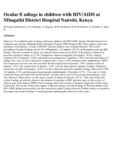| dc.description.abstract | Objective: To establish ocular fi ndings in Kenyan children with HIV/AIDS.
Design: Hospital-based cross sectional study
Setting: Mbagathi District Hospital (Nairobi) MSF-Belgium HIV clinic support
center and paediatric ward
Subjects: A total of 208 HIV infected children were examined
Results: The overall prevalence of ocular fi ndings was 67.3% (140 patients). 113
patients (54.3%) of the patients were on ARV therapy. The most common fi nding
was adnexal lesions observed in 40.9% of the patients, followed by posterior
segment fi ndings in 31.3%. Conjunctival microvasculopathy (30 patients,
14.4%), allergic conjunctivitis (27 patients, 13.0%) and molluscum contagiosum
12 patients, 5.8%) were the main adnexal fi ndings. Five cases (2.4%) of
infectious conjunctivitis, 4 cases (1.9%) of herpes zoster ophthalmicus (HZO)
and conjunctival growth were also recorded.
Keratoconjunctivitis (6 patients, 2.9%), anterior uveitis (6 patients, 2.9%), and
corneal ulcer (3 patients, 1.4%) were the main anterior segment fi ndings. Peripheral
retinal perivasculitis (28 patients, 13.5%) was the commonest posterior segment
fi nding, followed by CWS (18 patients, 8.7%) and presumed retinal pigment
epitheliopathy (18 patients, 8.7%) . Two cases of white retinal infi ltrate associated
with frosted branch vasculitis and 2 cases of focal retinal haemorrhages were also
observed. Tuberculosis was the major systemic fi nding (93 patients, 44.7%). This
study found that ocular fi ndings are directly related to the duration of exposure to
HIV infection (age), to the severity of clinical state of the disease (WHO clinical
staging) and to the severity of immune suppression (CD4 count).
Conclusion: The results of this study suggest a high prevalence of ocular fi ndings
in Kenyan children with HIV/AIDS. Retinal perivasculitis was the commonest
retinal fi nding observed. Further studies are needed to investigate the unusual
fi ndings of retinal pigment epitheliopathy observed in this study. | en |

